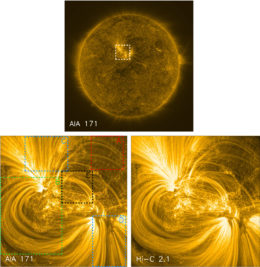Editor’s note: In these last two weeks of 2020, we’ll be looking at a few selections that we haven’t yet discussed on AAS Nova from among the most-downloaded papers published in AAS journals this year. The usual posting schedule will resume in January.
Is the High-Resolution Coronal Imager Resolving Coronal Strands? Results from AR 12712
Published April 2020
Main takeaway:
NASA’s High-Resolution Coronal Imager, or Hi-C mission, captured high-resolution images of the fine strands that make up the loops within the Sun’s outer atmosphere, the corona. The images, presented in a publication led by Thomas Williams (University of Central Lancaster, UK), demonstrate resolution on scales all the way down to ~200 km (~125 miles).
Why it’s interesting:

Top: The location of the active region explored with new Hi-C images (identified by the dotted box). Bottom: Comparison of SDO/AIA (left) and Hi-C (right) images of the coronal strands in the active region. Click for a closer look. [Williams et al. 2020]
Why these views are unique:
Perhaps surprisingly, Hi-C is not a space telescope parked in orbit and beaming these spectacularly high resolution solar images back to Earth. Instead, this imager was launched on a sounding rocket for its third time in 2018, and it produced these remarkable observations from just 329 seconds of data taken while the rocket was high in its arc through our atmosphere. The high quality of these images — even when compared with those of established space telescopes like the Solar Dynamics Observatory — highlights the need for a permanent solar observatory with the resolving power of Hi-C.
Citation
Thomas Williams et al 2020 ApJ 892 134. doi:10.3847/1538-4357/ab6dcf
